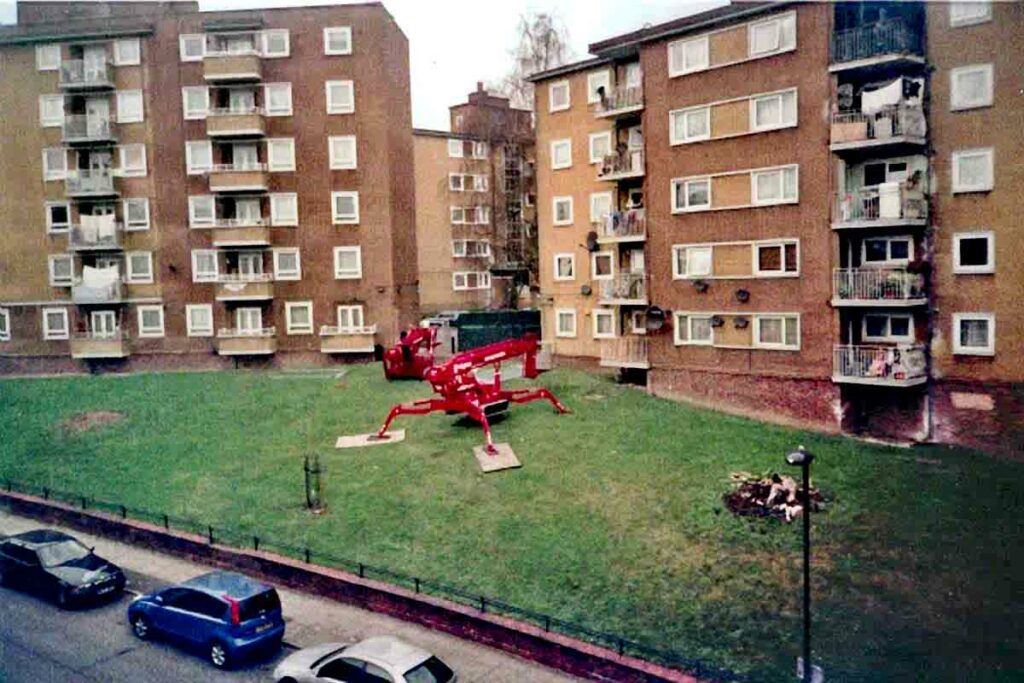
Lambeth council has started legal action against three housing associations as a result of sustained campaigning on behalf of local residents in the St Martins estate in Tulse Hill.
They have been challenging landlords to tackle damp conditions for six years but were repeatedly told the problems were their own fault.
They first won support from the council in 2019.
Housing on the estate is managed by three associations: Metropolitan Thames Valley, Optivo and Notting Hill Genesis.
Chris Blake, secretary of the St Martins Tenants Residents Association (TRA), said: “Residents have been complaining about damp for years, but it’s only coordinated action from a residents association that persuaded the council to commission a damp report.
“This shows there’s power in a union.”
The TRA organised mass door-knocking to help 87 residents complete a proforma complaint, building evidence for the scope and scale of the issue.
The campaign was conducted using community organising techniques with support from the High Trees Community Development Trust.
The issue impacts wide swathes of the estate and the TRA says it is probable that many more people who are experiencing damp have simply not made official complaints.

At least 23 blocks are known to be affected, containing over 600 flats, the TRA said.
Late last year Lambeth council released a damning report on damp on the St Martin’s estate.
It found that the housing associations had been blaming residents’ “behaviour and lifestyle” for condensation, damp and mould in flats.
The report confirmed that residents were correct, that the scale of the damp is significant, and that the housing associations had acted in bad faith, the TRA said.
Landlords on the estate “have been aware for a number of years that there are significant structural defects to the fabric of buildings,” the council report said.
But, rather than fix the issue, the report said, the landlords “routinely assume that the ‘lifestyle’ and ‘behaviour’ of residents is the primary factor for the presence of condensation damp and mould in flats.”
The report concludes: “No objective or quantifiable evidence has been produced to support these assertions.”
It also accuses the housing associations of adopting “an inherent victim-blaming approach” by both internal and third party assessors.
The council report found that it is more likely that structural defects, poor design and deficiencies in thermal insulation are the cause of damp and mould.
A letter from Sandra Roebuck, Lambeth council’s director of infrastructure and capital delivery, says that the action plan from the three associations falls short of the council’s expectations, because there is no clear defined work plans for individual blocks on the estate, nor are there any reasonable timescales set out in the plan, other than a commitment to works being completed by 2023 or 2025.
The letter concludes: “Regrettably the council, therefore, has little choice but to formally advise you that it will now begin the process of enforcement of housing standards under the Housing Act 2004.”

A 2017 report by the Notting Hill Genesis housing association estimated that £1.7m worth of repairs to external drainage to properties is required over 10 years to alleviate damp. The total is likely to be higher as this report only dealt with gutters and general drainage.
Marie Ellis, 47, has lived on the estate for 11 years. She said: “I don’t like the fact that we’ve been continually brushed off by our landlords.
“I’ve had problems with damp in my property since in moved in in December 2008.
“My toilet, bathroom and kitchen in my property was refurbished between July and August 2019.
“The kitchen never had damp, but it still remains in the toilet and bathroom.
“I worry about the effects on my family’s health. We are paying for a service and we need to get this sorted now.”
Nikki Murphy, 38, has lived on the estate since 2007 in accommodation managed by Notting Hill Genesis.
She said: “I have my windows open all the time. It’s always cold, but that does help to reduce the damp inside the property.
“Every day there is condensation on my front door.
“Water drips down from the ceilings in the communal areas, making the stairs slippery and unsafe.
“Our staircase is totally mouldy and there are icicles hanging from the ceiling.
“When I spoke to the housing association, they said they weren’t spending any money on external buildings to keep service charges down.
“But I don’t think these are acceptable living conditions.
“It makes me concerned for my family’s health. My daughter has asthma and I had Covid in March.
“My breathing has not been the same since. Damp conditions are not helpful when you suffer a breathing condition.”
Cllr Jennifer Brathwaite, Lambeth council’s deputy leader (housing and homelessness) said: “The residents of St Martin’s estate shouldn’t need to be fight so hard for their homes to be repaired.
“All housing providers in Lambeth have a responsibility to make sure that people’s homes are warm, dry and safe.
“Private landlords and housing associations are not exempt from this responsibility.
“We have a good working relationship with registered providers in Lambeth, with whom we work to provide homes for homeless families; facilities to strengthen local communities and jobs for local people.

“I expect the housing associations responsible for the St Martin’ estate to step up to the plate and rectify these longstanding issues.
“We’ll continue pressing the housing associations for remedial works to take place as soon as it is possible and will consider all options if action isn’t taken.”
Tulse Hill ward councillor Mary Atkins said: “It’s been a privilege for Tulse Hill councillors to work with residents on this campaign, but it is ridiculous it has taken so long.
“We need legislation that gives local councils more power of enforcement.”
St Martin’s TRA covers Abbots Park, Atwater Close, Challice Way, Ewen Crescent, Gaywood Close, High Trees and Vibart Gardens, as well as housing on Tulse Hill and Upper Tulse Hill.






